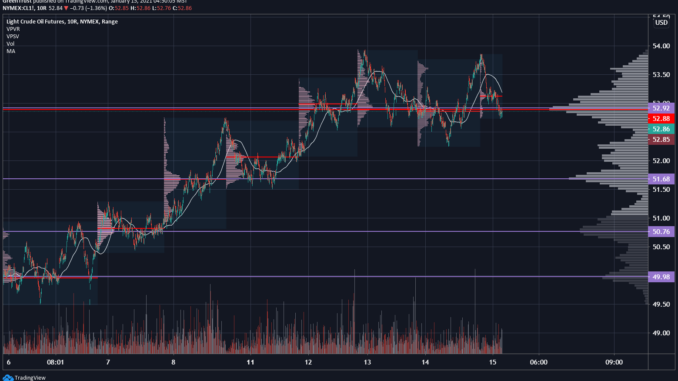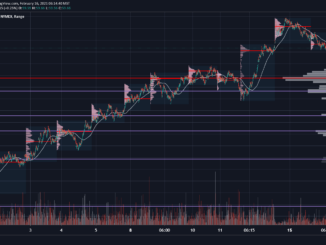
ENB Publishers Note: Do we see $54? Two touches, but no continuation move through. If we can get a bullish rig report, look out for a a break of that resistance line.
New York — Crude prices settled higher Jan. 14 as a weaker US dollar offset reports of weakened Chinese crude demand.
NYMEX February WTI settled 66 cents higher at $53.57/b, and ICE March Brent was up 36 cents at $56.42/b.
The US dollar turned lower in US trading after Federal Reserve Chairman Jerome Powell reaffirmed the Fed’s commitment to lower interest rates. Powell also said any tapering of asset purchases would be telegraphed in advance.
“Fed Chair Powell affirmed the Fed’s playbook and has tentatively put an end to any taper talk,” OANDA senior market analyst Edward Moya said in a note. “Dollar weakness resumed following Fed Chair Powell’s dovish commitment and on nervous anticipation over Biden’s stimulus package announcement later today.”
President-elect Biden is expected to present a sweeping pandemic relief and stimulus plan later Jan. 14 he has said previously would be worth “trillions.”
NYMEX February RBOB settled 51 points higher at $1.5539/gal, and February ULSD finished up 2.05 cents at $1.6194/gal.
In its closely watched oil market report released Jan. 14, OPEC kept its 2021 global demand forecast little changed at 95.91 million b/d, compared with 95.89 million b/d last month. The forecast is still 5.9 million b/d higher than 2020.
While rising COVID-19 infections and additional lockdown measures are affecting most major OECD countries, “the situation in emerging economies seems to have improved lately,” OPEC said.
But pandemic risks continue to stalk the market. Initial US unemployment claims jumped to a five-month-high 945,000 in during the week-ended Jan. 9, Labor Department data showed Jan. 14, exceeding market expectations of around 800,000 claims.
A weak labor market is likely to create headwinds for refined product demand recovery, especially gasoline. US driving activity edged 0.2% higher in the week ended Jan. 8, according to Apple mobility data, but was still near levels last seen in late May.
The ICE New York Harbor RBOB crack against Brent narrowed to $8.81/b in afternoon trading, in from $8.90/b the session prior.
China crude imports slow
China’s crude imports fell to a 27-month low of 9.096 million b/d, or 38.47 million mt, in December, according to General Administration of Customs data released Jan. 14.
The more than 15% year-on-year and month-on-month fall was sharper than had been expected, with analysts pointing to a shortage of crude import quotas and destocking activity as the key reasons for the decline, even as they forecast a strong rebound for January imports.
Having imported record volumes earlier in the year when crude prices were lower, the drop in December indicated that the country was well stocked and imports could fall back this year, some analysts said.
Total imports over 2020 were up 7% year on year to 10.86 million b/d, data showed.



